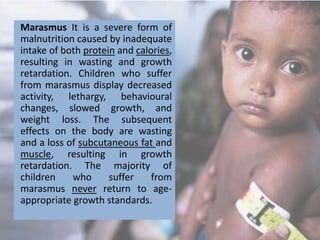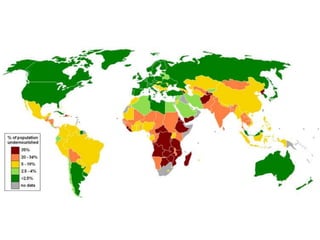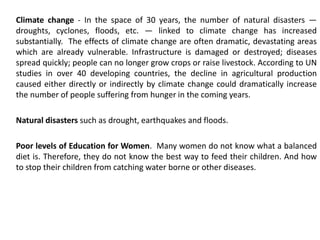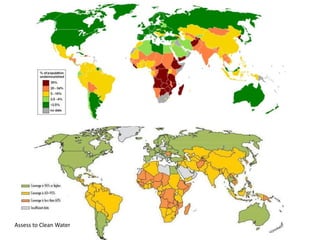MALNUTRITION
- 1. Malnutrition in all its forms increases the risk of disease (morbidity) and early death (mortality).
- 2. A balanced diet should comprise around 60% carbohydrate, 20% protein and 20% fat. Sufficient roughage, vitamins and minerals should also be included.
- 8. Marasmus It is a severe form of malnutrition caused by inadequate intake of both protein and calories, resulting in wasting and growth retardation. Children who suffer from marasmus display decreased activity, lethargy, behavioural changes, slowed growth, and weight loss. The subsequent effects on the body are wasting and a loss of subcutaneous fat and muscle, resulting in growth retardation. The majority of children who suffer from marasmus never return to age- appropriate growth standards.
- 20. Underlying Causes of Malnutrition. Poverty - Poverty is far from being eradicated. During the last two decades, the number of people affected by extreme poverty in sub-Saharan Africa has nearly doubled, from 164 million in 1982 to some 313 million as of 2002. Poverty alone does not lead to malnutrition, but it seriously affects the availability of adequate amounts of nutritious food for the most vulnerable populations. Over 90 % of malnourished people live in developing countries Lack of access to food - Most major food and nutrition crises do not occur because of a lack of food, but rather because people are too poor to obtain enough food. Non-availability of food on markets, difficult access to markets due to lack of means of transportation and insufficient financial resources are all factors contributing to the food insecurity of the most vulnerable populations. People are increasingly dependent on international markets for all or part of their food supplies, particularly between harvest periods. Many people are increasingly vulnerable due to fluctuations in the prices, as was recently illustrated during the global food crisis
- 21. Disease - Certain illnesses and infections, such as tuberculosis, measles and diarrhoea, amongst others, are directly linked to acute malnutrition. A combination of disease and malnutrition weakens the metabolism, forming a vicious circle of infection and undernourishment, leading to vulnerability to illness. HIV and AIDS has become a leading cause of acute malnutrition in developing countries. A child infected with HIV is more vulnerable to acute malnutrition than a healthy child. Anti- retroviral drugs are more effective when combined with adequate, regular food intake. So ensuring a healthy diet is an important aspect of HIV control and treatment. Lack of safe drinking water - Water is synonymous with life. Lack of potable water, poor sanitation and dangerous hygiene practices increase vulnerability to infectious and water-borne diseases, which are direct causes of acute malnutrition. Conflicts – They have a direct impact on food security, drastically compromising access to food. Often forced to flee as violence escalates, people uprooted by conflict lose access to their farms and businesses, or other means of local food production and markets. Abandoned fields and farms no longer provide food to broader distribution circuits. As a result, food supplies may be cut off to distributors, and the many populations dependent on them may be unable to obtain sufficient food.
- 22. Climate change - In the space of 30 years, the number of natural disasters — droughts, cyclones, floods, etc. — linked to climate change has increased substantially. The effects of climate change are often dramatic, devastating areas which are already vulnerable. Infrastructure is damaged or destroyed; diseases spread quickly; people can no longer grow crops or raise livestock. According to UN studies in over 40 developing countries, the decline in agricultural production caused either directly or indirectly by climate change could dramatically increase the number of people suffering from hunger in the coming years. Natural disasters such as drought, earthquakes and floods. Poor levels of Education for Women. Many women do not know what a balanced diet is. Therefore, they do not know the best way to feed their children. And how to stop their children from catching water borne or other diseases.
- 23. Assess to Clean Water
- 24. Assess to Clean Water

























